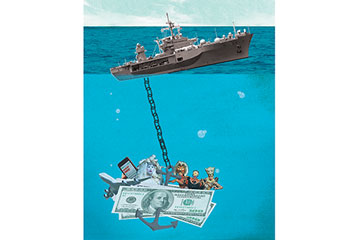
The U.S. 7th fleet packs all the power and majesty one would expect from the world's biggest armada: about 65 ships, 300 aircraft and 40,000 personnel, ranging over an area of operations that covers one-quarter of the earth's surface. But a force that size runs more on guts than glory: 30 cents of every Navy dollar goes not to the purchase of the ships or the salaries of sailors but to the much less glamorous category called operations and maintenance. That includes $180 million annually for such outlays as sewage-removal services that pump waste from nuclear-powered carriers into rusty scows and vast chow deliveries that feed shipboard populations the size of small towns.
It was in that logistical netherworld of provisioning that the Malaysian millionaire Leonard Glenn Francis allegedly collaborated with a small but growing number of officers to perpetrate a scam that prosecutors estimate cost U.S. taxpayers at least $20 million. In exchange for bribes of cash, hotel stays, hookers and tickets to Lady Gaga concerts, shore-based Navy officers responsible for scheduling 7th Fleet port visits funneled ships to what Francis called his "pearl ports" around the western Pacific, where he allegedly over-charged them for everything from fresh-water to bolstered post-9/11 security.
The Navy, like the U.S. military as a whole, has seen its $150 billion annual budget nearly double since 9/11. And while all those budgets are tightening now after two wars and a sequester, the billing scandal is a reminder that the service's bookkeeping and oversight have not kept pace with its ever improving weapons systems, especially when it comes to operations abroad.

